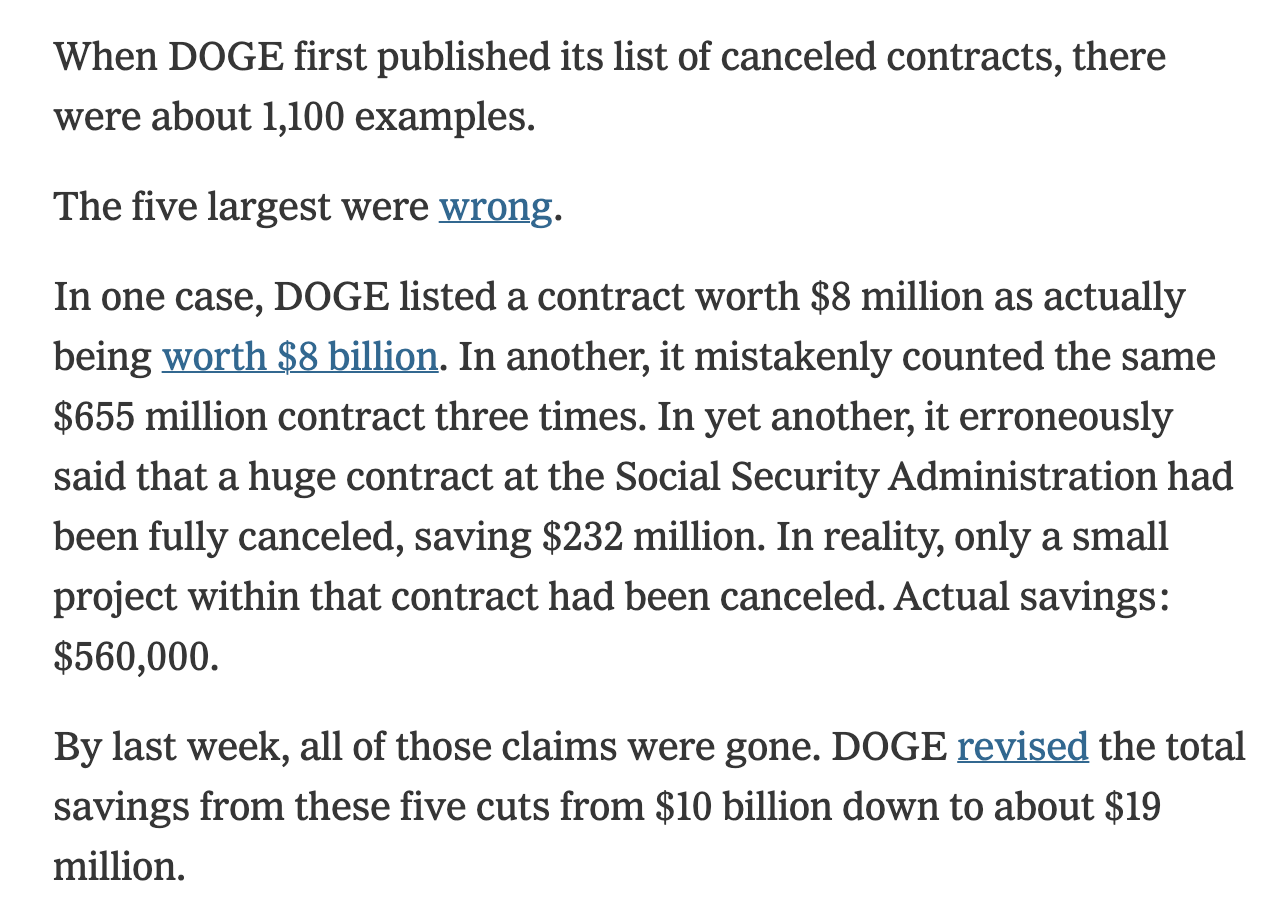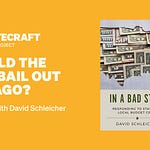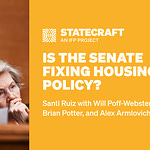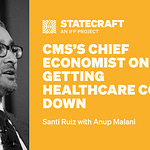DOGE is the most interesting story in state capacity right now. Yet although we’ve talked around it on Statecraft, I haven’t covered it directly since the beginning of the administration. In part, that’s because of the whirlwind pace of news, but also because of the sense I get in talking to other DOGE watchers, that we’re like blind men feeling different parts of the elephant. And, frankly, because it’s the most polarizing issue in public discourse right now.
But we’re far enough into the administration that some things are clear, and I think it’s relevant for Statecraft readers to hear how I’m personally modeling DOGE. We’re also far enough along that it’s worth taking stock of what we expected and forecasted about DOGE, and where we were wrong. So here are 50 thoughts on DOGE, as concisely as possible. Effective altruists do this thing in their online posts where they specify the “epistemic status” of a post: how confident they are about the claims they’re making. The epistemic status of this essay: low to medium confidence. [Editor’s notes like this one were added after the piece was published.]
Our extraordinarily adversarial information environment
This is too broad a topic to do justice to here, and if you spend time on the internet you likely have your own view. My view, briefly:
Elon Musk has many great strengths, but he is not a reliable narrator.
Elon has engineered his Twitter experience in a way that constrains the information he is able to receive, which adds to the unreliable narrator problem. Elon also spends a prodigious amount of time on Twitter. The feedback loops he generates from tweeting shape his actions at DOGE to a degree I did not expect.
In 2020, Venkatesh Rao wrote, “Online public spaces are now being slowly taken over by beef-only thinkers, as the global culture wars evolve into a stable, endemic, background societal condition of continuous conflict.”
Elon noticed this trend, enjoys partaking in beef, and has incentivized beefing as the modal form of Twitter engagement since taking over the company. The algorithm rewards beefing more now (more quote tweets and screenshots).
But it’s not just Twitter: “subscriber capture,” the incredible incentives for mainstream media outlets to cover Trump as salaciously as possible, and the architecture of the internet itself all make it very difficult to find reliable narrators.
The media actors rewarded in this ecosystem are those who are good at leveraging and maintaining beefs with other actors, which in practice means partisans of one or another stripe.
All of the above means that Elon looks into problems that are largely driven by institutional capture, structural incentives, and overregulation, and sees them instead as problems of waste, corruption, and fraud. Again, I don’t think this is about Elon’s personality so much as it is about the way the information he receives is structured. The more time you spend on the PvP platform that is social media, the more you will be primed to see enemies everywhere.
There’s likely some malicious compliance from disgruntled federal actors, and a huge amount of selective leaking. For an example of the latter, see the firestorm over the administration purportedly canceling cyber operations against Russia (it didn’t). Many stories you read are true only in the most technical sense. If you do not believe this or do not come from a subculture that is used to being misrepresented in mainstream media, see this good list from Zvi Mowshowitz of the ways formally correct journalism can practically mislead.
Information silos are crazier than ever.
For example, I’ve been privy to two parallel, heated debates about foreign aid over the past half-decade. People who work in foreign development (especially effective altruists) have engaged in a battle about the efficacy of various forms of foreign aid: what works best, what works less well, what doesn’t work at all, and how we can know.
Meanwhile, right-wingers have spent much of the last decade (since the summer of 2020 in particular) documenting how deeply embedded left-wing NGOs are in many federal (and local) funding programs, and developing a critique of that tight federal/NGO linkage.
[A reader points out that some of the criticism of American foreign aid on the right is older, and comes from a broader critique about the liberal world order — I think that’s also true.]
But neither debate exhibits much awareness of the other at all, with very negative consequences. The DOGE team has axed the most effective and efficient programs at USAID, and forced out the chief economist, who was brought in to oversee a more aggressive push toward efficiency. It does not appear to be interested in engaging with what we know about more or less effective humanitarian aid.
And people in the NGO class were completely blindsided by the animosity the Trump administration had toward them and the speed at which many of their contracts would be torn up.
To stay informed on DOGE, I’m drinking from the firehose a bit: one part mainstream coverage from folks like Jeff Stein, Kyle Cheney, Teddy Schliefer, and Josh Code, one part right-wing Twitter, one part Elon’s tweets, two parts various DC and Silicon Valley groupchats.
The role of Elon himself
One common view of DOGE is that Elon is functioning as a kind of “sin eater” or fall guy for Trump, doing the dirty work that the President himself won’t do. I don’t think there’s much to that view, and I don’t think it helps explain what’s happening at DOGE. See Trump’s speech to Congress on Tuesday, which emphasized the cuts happening across the federal government.
Elon, and DOGE, currently maintain remarkable freedom of action across the federal government. Sources I’ve talked to within the administration do not have a better or more coherent sense of what DOGE is doing on a given day. They also describe DOGE operations as rather freelance-y: often, DOGE team members arrive on detail at a federal agency without a specific mandate except to poke around. [About two hours after I published this post, President Trump held a press conference in which he suggested DOGE would wield less authority within Cabinet-level agencies going forward. Something to watch.]
One model of Elon’s political worldview is folk-libertarianism of the Tea Party variety. Another is “a kind of right-Maoism,” as Chris Beiser suggests. Beiser points out several organizing principles, including “Mobilization through intense, ideological campaigns organized around concise edicts” and “Rapid and repeated reorganizations, aimed at preventing alternate power centers from developing.” I think there’s something there.
And there’s a longer essay to be written here about how Elon rhymes with other right-wing activists, from Chris Rufo to Steve Bannon, who have inherited principles from other communist thinkers, like Lenin.
[Friend-of-Statecraft Dwarkesh Patel writes in with a quote from Chen Yun, a leading Chinese Communist Party official under Mao: “Had Mao died in 1956, his achievements would have been immortal. Had he died in 1966, he would still have been a great man but flawed. But he died in 1976. Alas, what can one say?”]
Some of you will remember Elon’s involvement in the CR fight on the Hill in December, where it seems like the sole metric he cared about was bringing down the number of pages in the bill. Lots of the pages that were struck were important context or nuance around spending that was already going to happen. In retrospect, that episode was a foreshadowing.
What Statecraft got wrong
Early on, it seemed like DOGE would be a glorified blue ribbon commission, and I thought about what it would be able to accomplish in those terms. Although I don’t think anyone expected that DOGE would be placed in the preexisting, Obama-created shell of the US Digital Service, I was probably too confident that it would take a particular form.
Many of my early instincts were based on what Vivek Ramaswamy was saying DOGE would be and would focus on. I don’t think I updated quickly enough after Vivek exited — he clearly had a more sophisticated vision than Elon’s. You can argue about whether it’s good or bad, but it was grounded in a particular conservative critique of the administrative state. See the WSJ column by Elon and Vivek (which Vivek wrote and filed himself).
As the WSJ reported later, the Elon/Vivek split “was… predicated in part by DOGE’s increasing attention on achieving spending cuts, which Musk has championed, and less of a focus on cutting regulations and bureaucracy, which had been helmed by Ramaswamy.”
The Vivek model of DOGE had a theory that overregulation constrains American economic growth, and it’s a theory I mostly subscribe to. But DOGE as it exists now is not especially focused on regulatory rollback, and to the extent that it’s happening it’s elsewhere in the Trump administration.
DOGE in its Elon iteration is much more focused on two metrics: number of federal employees and dollars saved. I have been told that given the political pressures on it, DOGE is focusing staffers on projects that have a figure associated with them, either headcount or dollar spend. Those are brute metrics that are quite vulnerable to Goodhart’s law: “When a measure becomes a target, it ceases to be a good measure.” I do think there’s plenty of wasteful spending in the federal government, and one of the upsides of DOGE is clearly the potential of creating a federal culture that is more aware of how it spends taxpayer dollars (more on this shortly).
But the parts of “government efficiency” that are easiest to message to the public are not the parts that improve state capacity. We've seen a lot of the Rand Paul-style tweeting from Elon about bad or silly experiments that science agencies fund — the shrimp running on treadmills stuff — the $500,000 we spent on this or that.
The metrics DOGE is explicitly measuring against are public, but another goal of DOGE is “destroy internal enemies and punish the opposition and take the stuff they like away.” To take one obvious example, the agencies being targeted for layoffs are disproportionately the ones that code left-wing. You don’t read this newsletter for psychoanalysis of political figures, but there’s definitely plenty of this going on:
Fires and hires
In November I wrote a piece for The Free Press on “The Five Things President Trump Should Do.” Although I had written the piece before the general election and edited it only lightly after — the recommendations for the next administration were drawn from a broad range of our interviews and were intended to apply to either potential president — there was one recommendation that seemed especially relevant to an incoming Department of Government Efficiency. “Hire Bureaucrats, Just Make Them the Right Ones,” it said, and emphasized that our current system makes it too hard both to fire bad bureaucrats and to hire better ones.
“A strategic administration will encourage agencies to find creative ways to bring in top talent. It could try using new tools to assess technically talented applicants in bulk, or it could increase the number of academic rotations through the Intergovernmental Personnel Act, which allows academics to contribute part-time to special federal agency projects. The Office of Personnel Management can and should encourage more aggressive use of Direct Hire Authority, allowing agencies to avoid certain procedural steps of the federal hiring process.”
So far, DOGE has focused only on the firing part, and not at all on the hiring part. That’s a shame for a couple reasons. It’s a missed opportunity to fix the talent pipelines that plague federal hiring. And because DOGE is constrained by a preexisting set of rules around reductions in force, the people DOGE is firing are disproportionately the more talented and more useful people. In December, I went on the American Compass podcast with Oren Cass to do some forecasting and wishcasting of DOGE. Although some of our conversation was overindexed on Vivek’s public statements, there’s one particular section I want to note, and it’s linked here. We expected that DOGE would run into trouble if it tried to cut federal headcount with across-the-board actions, because of the way civil service protections are structured:
“Title V, Part 351 of the Code of Federal Regulations means that if you're doing reductions in force across the board, you have to start with employees who are serving in specific temporary positions or those under specific special authorities, before you get to the career employees who have been there for 20 years.”
DOGE has indeed tried to cut federal headcount extremely aggressively (one estimate suggests it’s cut 20,000 federal employees so far, although that may not be right). They’ve gone about this by, as we expected, firing probationary employees and those hired under certain special authorities. Unlike tenured federal employees, probationary employees cannot appeal to the Merit Systems Protection Board (MSPB) unless they claim discrimination or whistleblower retaliation. Note that probationary doesn’t just mean “in your first year on the job,” but also those who have been recently promoted.
In many cases, the probationary employees are exactly who I would not like DOGE to fire, from an efficiency standpoint: they’re the younger, less entrenched, more technologically savvy people. Take the Bureau of Industry and Security, an agency within the Department of Commerce. BIS is mandated to enforce American export controls on “dual-use technologies,” like uranium enrichment technologies and high-end semiconductor chips. From a team of about 500, DOGE canned about 15 people. At least a handful of them were (in my view) some of the people best positioned to improve our ability to keep Chinese hands off the most powerful AI technologies. A similar dynamic has played out across the federal government.
Firing probationary employees is what you do if your problem definition is, “there are too many employees of the federal government and there should be fewer.” It’s not what you would do if you defined the problem as, “we can’t fire bad employees,” or, “good federal employees are constrained by too much process.”
The administration is also shuttering the Presidential Management Fellowship, a small program that made it easier to hire new graduates outside of the usual clunky federal hiring process.
Whether the cuts to probationary employees will continue is unclear at the time of writing. Many of these layoffs are being contested in court, and some of them have been undone already. You should expect long, drawn-out fights over unfair firings, and people who win their suits will be very expensive future cost streams.
It’s plausible that DOGE will focus on the hiring side later, and is concentrating on the painful parts now. See Machiavelli: “Therefore any cruelty has to be executed at once, so that the less it is tasted, the less it offends; while benefits must be dispensed little by little, so that they will be savored all the more.” But I would not rely on this theory without further evidence.
As has been well covered in mainstream outlets, DOGE has been extremely sloppy about cutting contracts and reporting the numbers. Most of the biggest ticket savings have been the result of DOGE misreading federal contracting data, or killing contracts that were already dead. From the New York Times:
What’s more concerning than the sloppiness itself is that it does not appear to be getting resolved over time. The same kinds of data parsing errors and confusion about how federal contracts are awarded and then paid out have persisted over two months. Some of this comes back to the information environment: DOGE has instituted few if any ground-up mechanisms within the federal government to surface real savings opportunities.
In January, I wrote a piece with my colleague Matt Esche calling for better data collection in the federal government, and listing a set of places the Trump administration could start. There have been some encouraging signs on this front, like future NIH head Jay Bhattacharya’s commitment to focusing on “replicable, reproducible, and generalizable” science. But DOGE has made some missteps; for instance, as Stuart Buck has documented, it has canceled some of the most valuable long-run education studies we have. This is one of the best examples of a “penny-wise, pound-foolish” orientation at DOGE: the studies cost almost nothing, provide information no private actor can provide, and create the basis for smarter policymaking at the federal and state levels.
How much of this would have happened without DOGE?
DOGE is a label that’s getting slapped on all kinds of Trump administration activities, including activities that are unrelated to the actual Elon-helmed DOGE. There seem to be a couple reasons for this: for one, it’s good branding for the administration, and there are incentives for non-DOGE initiatives to claim the DOGE mantle. For admin critics, calling everything DOGE plays into an “Elon shadow president” rhetorical attack. So as a result, it can be hard to tell what’s what.
Analytically, I’ve been trying to separate out the DOGE stuff that would have happened anyway from the stuff that’s a result of the particular Elon DOGE project. There’s the Elon playbook, which we’ve seen at Twitter and SpaceX, of turning everything off and on and seeing what breaks. But there are also other actors involved in DOGE, and many of them are executing playbooks that would have been used anyway, even if Elon had never come on board.
For example, many conservatives have pushed for the Department of Education to be dismantled since it was created. Chris Rufo put together a detailed playbook for doing so. In a world without DOGE, you would still see an attempt to shutter or to aggressively limit the department.
The Consumer Financial Protection Bureau is another interesting example. Headlines say DOGE is canceling hundreds of contracts at the CFPB and imposing stop-work orders. But emails show that the push to functionally shutter the CFPB is not coming from DOGE, but from its Acting Director Russ Vought, who is also Trump’s head of the Office of Management and Budget (you may remember our interview with him from last fall). The Chief Legal Officer of the CFPB is Mark Paoletta, a close Vought ally; he’s long advocated for the CFPB to be shut down entirely. I think it’s fair to say that DOGE is not the reason the CFPB is in tumult right now, even if it’s the proximate cause.
Vought and Paoletta also believe (and have argued) that the president constitutionally has the power to choose not to spend, or to “impound,” money that Congress has appropriated. Vought believes in unitary executive theory, that there constitutionally is no such thing as an independent federal agency. DOGE is working closely with Vought’s OMB, and the moves to freeze congressionally appropriated money are originally Vought’s idea.
The shuttering of USAID is a fuzzier story. DOGE clearly played a key role in it, as did OMB. But the acting head of USAID, Peter Marocco, attempted many of the same moves in the first Trump administration. See the 13-page dissent memo from his first time at USAID: “Marocco has leveraged once-routine administrative processes to reopen previously-approved plans, interrogate and redirect country programs, halt movement on programs, procurements, and people, and inject uncertainty into daily operations and office planning.’” From recent reporting, Marocco and DOGE appear to be at odds with some White House and State Department staff over USAID funding.
Elon’s statements on USAID have been all over the map in the last two months: at one point, he tweeted about “feeding USAID into the woodchipper,” but now he describes those actions as “a brief pause to do a sanity check on foreign aid funding.” I don’t believe that second description is an accurate representation of what has happened to humanitarian aid through USAID. Elon has also said that Ebola prevention funding was accidentally cut and then restored, when it has not been restored. I would be doubtful of claims from DOGE about the status of USAID without independent verification.
USAID is a very frustrating story, and, for me personally, it’s the DOGE move that’s truly egregious, as opposed to uncomfortable, foolish, or poorly executed. Our first conversation on Statecraft was on PEPFAR, which is an extraordinarily effective American institution that has saved millions of lives. There have been a variety of claims about the cuts to foreign aid: that the cuts aren’t bad, that the cuts must not actually be to lifesaving stuff, that USAID defenders are using programs like PEPFAR as a “hostage puppy” to protect the bad or wasteful things USAID funds, and so on. But I don’t think these arguments have merit. There are good things USAID funds, and wasteful things it funds, and good governance means being able to distinguish between the two.
But I should also point out that we’ve covered the failings of USAID in depth: for instance, our conversation with Kyle Newkirk, who ran procurement for USAID in Afghanistan. If you dug into the story of American aid involvement there, what you found was report after report from inspectors general and the Government Accountability Office blasting USAID for the same issues: inability to track where money was going, refusal to subject itself to Congressional oversight, and a lack of long-term planning.
I cataloged a few examples in this thread in March 2024. In many cases, oversight bodies all but directly accuse USAID of lying: “The information reported by USAID to decision makers in Washington, D.C. did not accurately portray the status of the overall assistance effort."
USAID may end up being folded into the State Department, perhaps via the Development Finance Corporation. Politicians as different as Madeline Albright and Marco Rubio have wanted to make this happen. I think it’s quite plausible that this leads to a better, leaner, more politically accountable USAID in the long run. But in the meantime, real lifesaving aid has been halted and the systems that administer it have been broken.
A personal story on USAID and PEPFAR: last year, before the election, PEPFAR was up for reauthorization, and global health advocates worried that it would only be reauthorized for one year, rather than the typical five years. Rep. Chris Smith (R-NJ) was one of the original cosponsors of PEPFAR, but was unwilling to support a full reauthorization without assurances that PEPFAR dollars weren’t going to perform abortions or to groups that lobbied for abortion access in Africa. Negotiations over PEPFAR reauthorization were stalled for months: Republicans were unwilling to countenance a longer reauthorization, and Democrats weren’t willing to explicitly rule out support for abortion in the “reproductive services” mandate of PEPFAR (the program works largely with pregnant mothers).
I spent some time connecting global health advocates with Republican Hill staffers on the issue. The staffers informed me that they had been asking PEPFAR for a list of its subgrantees for months, and that PEPFAR had stonewalled; it was unable or unwilling to provide that data.
It later came out that PEPFAR dollars had gone to nurses who performed at least 21 abortions in Mozambique. That information came out through a CDC review of its grantees, not from PEPFAR itself.
Readers can come to their own conclusions about who is politically or morally responsible for the aid pause. My point is that the dynamics that led us to this moment have been a long time brewing.
The good parts
Some things that DOGE is doing that I like:
Bringing real technical talent in, like Airbnb cofounder Joe Gebbia, to fix specific systems.
Modernizing and integrating IRS data systems.
Improving the tech stack across the whole of the federal government. I think the jury is still out on whether this Executive Order will be implemented in the way observers like Sam Hammond expect it to, but there’s potential for real upside here.
The general culling of handouts via contract to politically aligned NGOs.
The biggest federal contractors (or “Beltway bandits”) are malign actors that benefit from wasteful contracting practices, and they are very worried about losing access.
We’re going to see major artificial intelligence advances during this presidency, and tech modernization in the federal government will be essential for navigating that reality (along with more complex and data-rich versions of DOGE’s “whole-of-government” chart). Again, for me the jury remains out on how much of that modernization will happen through DOGE. We’re only a few weeks in. This is another place where my error bars on DOGE’s impact are extremely wide — it’s just not clear to me yet whether the federal agencies that avoid getting slashed like USAID will emerge from this stronger and more effective or not. But as friend-of-Statecraft Dean Ball has pointed out, “A country with excess intelligence but dysfunctional institutions may not be a superpower for long.”
At Statecraft, we care about institutions getting better at their core missions. Sometimes that involves cutting waste. It’s quite plausible that cutting headcount and automating more systems will help certain federal agencies do their work better. But we tend to think that many of the problems with federal agencies come from regulatory and procedural burdens on the agencies themselves. From that perspective, the solution isn’t to punish civil servants, but to release them from crappy strictures that make them worse at their jobs.
Friend-of-Statecraft Sam Hammond says that the people interested in state capacity (all 12 of us) on the left and the right tend to have different ideas of what state capacity means. But (as he points out later in the thread) the two aren’t mutually exclusive.
DOGE is using the right-leaning definition of “state capacity.” But if you want Singapore-style effectiveness, you need to do some things that historically coded left, like paying civil servants more and giving them more freedom.
Where we’re headed
Statecraft is a quasi-journalistic publication, but our strength is not in breaking news reporting. We’ll be following DOGE closely and aiming to give you special insight into it when we can, or when we can find an interviewee who can. But we think a big part of our value-add is providing historical and institutional context, and that will continue to be our focus. There are a number of stories we think can shed light on what DOGE is doing now: stories like Al Gore’s Reinventing Government push, or Albright’s attempt to bring USAID under tighter political control, or how IRS DirectFile was built, to name a few. If you have other ideas, we’d love to hear from you.
The medium-term question I’m watching is an upcoming fight at SCOTUS over the president’s impoundment authority. The administration wants this question taken up by this court. I have my doubts that the court will fully take the administration’s position — that the president can choose not to spend congressionally appropriated money — but it’s certainly not outside the realm of possibility. And that creates a real issue for Congress: how do you build the bipartisan trust to pass a budget bill if one side can’t prove the president won’t turn off the parts he doesn’t like?
Frankly, I still find it hard to evaluate DOGE in toto. There are things I hate and things I very much appreciate, but it still feels too early to pass judgment on whether DOGE is or will be a net positive or negative. I understand if readers feel this is a cop-out, but we’ll continue to cover DOGE in the coming months. There’s a lot more to say, but I’ll just flag two great essays by Alana Newhouse: they’re about how the left and right increasingly are defined by their rival views of American institutions. How you feel about a given agency getting “DOGE’d” depends largely on if you think the agency was broken or not to begin with.
Thanks to Beez for her edits on this piece. Statecraft is a project of the Institute for Progress (IFP), an innovation policy think tank in DC.


















